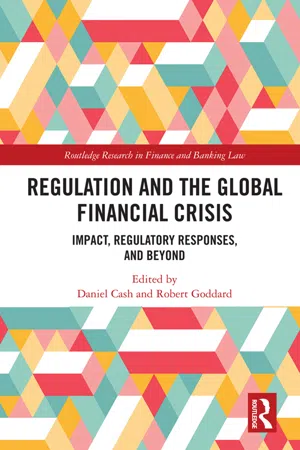
Regulation and the Global Financial Crisis
Impact, Regulatory Responses, and Beyond
- 264 pages
- English
- ePUB (mobile friendly)
- Available on iOS & Android
Regulation and the Global Financial Crisis
Impact, Regulatory Responses, and Beyond
About This Book
The Financial Crisis was a cross-sector crisis that fundamentally affected modern society. Regulation, as a concept, was both blamed for allowing the crisis to happen, but also tasked with developing and implementing solutions in the wake of the crash.In this book, a number of specialists from a range of fields have contributed their insights into the effect of the Financial Crisis upon the regulatory frameworks affecting their fields, how regulators have responded to the Crisis, and then what this may mean for the future of regulation within those industries. These analyses are joined by a picture of past financial crises – which reveals interesting patterns – and then analyses of architectural regulatory models that were fundamentally affected by the Crisis. The book aims to allow sector specialists the freedom to share their insights so that, potentially, a broader picture can be identified.Providing an interesting and thought-provoking account of this societally impactful era, this book will help the reader develop a more informed understanding of the potential future of financial regulation. The book will be of value to researchers, students, advanced level students, regulators, and policymakers.
Frequently asked questions
Part 1
Structured response
1 Three major financial crises
What have we learned?*
Introduction
The AFC
An overview of the AFC
Causes of the AFC
Financial sector weaknesses: failure to intermediate capital flows effectively
Premature liberalisation of domestic financial markets
Fixed exchange rates
Table of contents
- Cover
- Half Title
- Series
- Title
- Copyright
- Contents
- List of contributors
- Introduction
- Part 1 Structured response
- Part 2 Tales from the marketplace
- Index